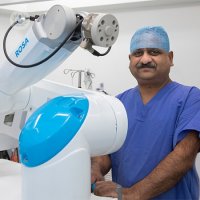Robotic-assisted knee replacement: What are the benefits?
Escrito por:In his latest article renowned consultant orthopaedic surgeon Mr Muthu Ganapathi explains the cutting-edge surgical technique, robotic-assisted personalised knee replacement. He explains how the surgery is done, the benefits, and who the procedure is suited to.
What is robotic-assisted personalised knee replacement?
Robotic-assisted personalised knee replacement is a state-of-the-art surgical technique that combines the expertise of highly skilled orthopaedic surgeons with advanced robotic technology. The procedure is designed to address various knee conditions, including osteoarthritis, rheumatoid arthritis, and post-traumatic arthritis. Through this approach, surgeons can achieve unparalleled accuracy and customisation, resulting in improved outcomes and quicker recovery times.
How does the robotic-assisted knee replacement procedure work?
The procedure begins with a comprehensive preoperative assessment that includes a detailed analysis of the patient's knee joint through advanced imaging techniques. This data is then incorporated into a computer software program, allowing the surgeon to create a personalised surgical plan based on the patient's unique anatomy and alignment.
During the surgery, the surgeon guides a robotic arm with the assistance of real-time imaging, enabling precise removal of damaged bone and tissue. The robotic system ensures that the implants are precisely positioned, promoting better alignment and reducing the risk of complications.
What are the benefits of robotic-assisted knee replacement?
There are a number of benefits, including:
- Enhanced precision: The robotic arm's accuracy surpasses traditional methods, leading to a more accurate placement of implants, which may result in improved joint function and longevity.
- Customisation: Each patient's anatomy is unique, and this technology allows for personalised treatment plans that cater to individual needs, leading to a better fit and improved surgical outcome.
- Faster recovery: The minimally invasive nature of robotic-assisted surgery often leads to reduced trauma, less post-operative pain, and quicker recovery times compared to conventional knee replacement procedures.
- Reduced complications: The precision of robotic assistance reduces the risk of errors and complications during surgery, providing patients with greater peace of mind.
- The personalised treatment plan with robotic-assisted knee replacement has been shown in recent studies to improve functional outcomes.
Is robotic-assisted knee replacement suitable for everyone?
Almost all patients who are candidates for conventional knee replacements will be suitable for robotic-assisted knee replacements. In fact, in some patients where conventional instrumented knee replacement is not possible (for example previous fractures or with previous metal work), robotic-assisted knee replacement can be done. Your orthopaedic surgeon will thoroughly assess your condition and advise you on the most appropriate treatment option for your individual needs.
What is the recovery process like?
Recovery from robotic-assisted knee replacement is often smoother and faster than traditional methods. Patients typically participate in a comprehensive rehabilitation program, which may involve physical therapy and exercises to improve strength and mobility. Your surgeon will provide specific guidelines tailored to your condition to facilitate a successful recovery.
References:
- Robotic-assisted total knee arthroplasty improves accuracy and precision compared to conventional techniques. Bone Joint J 2021 Jun;103-B (6 Supple A):74-80.
- Robotic-arm assisted total knee arthroplasty is associated with improved early functional recovery and reduced time to hospital discharge compared with conventional jig-based total knee arthroplasty: a prospective cohort study. Bone Joint J 2018 Jul;100-B (7):930-937.
- Patient satisfaction following total knee arthroplasty using restricted kinematic alignment. Bone Joint J 2021 Jun;103-B (6 Supple A):59-66.
- Maintaining Joint Line Obliquity Optimizes Outcomes of Functional Alignment in Total Knee Arthroplasty in Patients with Constitutionally Varus Knees. J Arthroplasty 2023 Jul;38 (7 Suppl 2): S239-S244.
If you would like to book a consultation with Mr Muthu Ganapathi, you can do so today via his Top Doctors profile.



